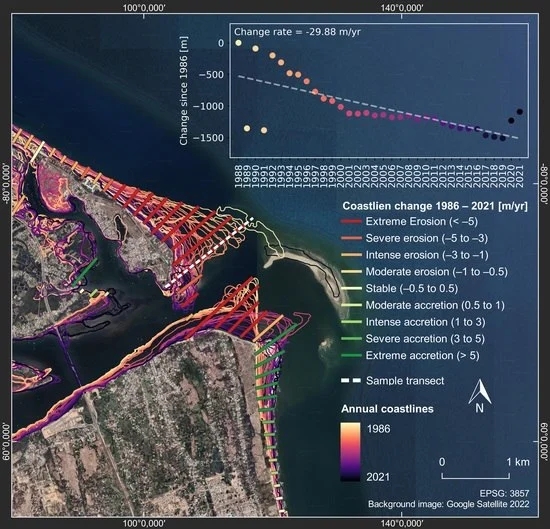Ronja Lappe, a recent EAGLE graduate, published her thesis as article in Remote Sensing: “State of the Vietnamese Coast—Assessing Three Decades (1986 to 2021) of Coastline Dynamics Using the Landsat Archive”. From the abstract: “Vietnam’s 3260 km coastline is densely populated, experiences rapid urban and economic growth, and faces at the same time a high risk of coastal hazards. Satellite archives provide a free and powerful opportunity for long-term area-wide monitoring of the coastal zone. This paper presents an automated analysis of coastline dynamics from 1986 to 2021 for Vietnam’s entire coastal zone using the Landsat archive. The proposed method is implemented within the cloud-computing platform Google Earth Engine to only involve publicly and globally available datasets and tools. We generated annual coastline composites representing the mean-high water level and extracted sub-pixel coastlines. We further quantified coastline change rates along shore-perpendicular transects, revealing that half of Vietnam’s coast did not experience significant change, while the remaining half is classified as erosional (27.7%) and accretional (27.1%). A hotspot analysis shows that coastal segments with the highest change rates are concentrated in the low-lying deltas of the Mekong River in the south and the Red River in the north. Hotspots with the highest accretion rates of up to +47 m/year are mainly associated with the construction of artificial coastlines, while hotspots with the highest erosion rates of −28 m/year may be related to natural sediment redistribution and human activity.”
read the full article here: Lappe, R.; Ullmann, T.; Bachofer, F. State of the Vietnamese Coast—Assessing Three Decades (1986 to 2021) of Coastline Dynamics Using the Landsat Archive. Remote Sens. 2022, 14, 2476. https://doi.org/10.3390/rs14102476








